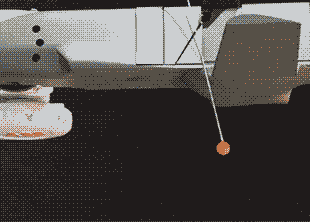The American company General Atomics has shown how the MQ-9A Reaper attack drone will pick up a small Sparrowhawk jet in flight. This will help him with a cable with an orange sphere at the end, which Sparrowhawk will cling to with flaps.
The US military has been teaching large drones to launch small ones for several years. For example, last summer, the MQ-1C Gray Eagle strike launched the Altius-600 reconnaissance aircraft, and this spring the [...] Valkyrie unmanned wingman did the same. This technology should extend the life of more expensive devices and increase the area of reconnaissance from the air.
What happens to small drones after launch is another question. Reconnaissance Altius-600s during tests with the MQ-1C in most cases landed "on their bellies", or they were picked up by a quadrocopter using an aerial finisher cable. The company Dynetics offers to catch small drones using a rod similar to the one used in the refueling system. However, in her case, the plane will catch the devices.
General Atomics last year conducted flight tests of the MQ-9A Reaper with a Sparrowhawk suspended on it. So it became known about the existence of a small drone with a jet engine, a V - shaped tail and a rotary wing. During the tests, Sparrowhawk did not start and nothing was reported about the method of its return to the Reaper.
In July, General Atomics showed how an attack drone would pick up a Sparrowhawk in flight. To do this, the Reaper uses a relatively thin cable with an orange sphere at the end, for which a small drone can cling with two flaps. Once secured, the Sparrowhawk turns the wing 90 degrees so that it is parallel to its fuselage. After that, the Reaper returns it back to the suspension under the wing.
The company also revealed some characteristics of Sparrowhawk. With a mass of less than 227 kilograms, its length will be 3.3 meters, and the wingspan will be 4.3 meters. The Sparrowhawk will be able to fly up to 926 kilometers with a cruising speed of 80 knots and stay in the air for at least 10 hours. It will be equipped with a hybrid power plant.
The US military expects that in the future large drones will be able to launch not one, but many small tactical drones, as we wrote earlier.
Vasilisa Chernyavtseva

